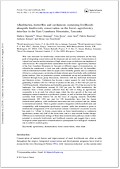| Journal Article |
 |
|
| Article Title | Allanblackia, butterflies and cardamom: sustaining livelihoods alongside biodiversity conservation on the forest | | Author | Mathew Mpanda, Moses Munjuga, Teija Reyes, Amir Said, Fidelis Rutatina, Anthony Kimaro and Meine van Noordwijk | | Year | 2014 | | Journal Title | Forests, Trees and Livelihoods | | Institution | Taylor & Francis | | Volume | 23 | | Issue | 1-2 | | Pages | 127-142 | | Call Number | JA0586-14 | | Keywords | agroforestry; domestication; forest conservation; value chain |
|
| Abstract: |
| Win–win outcomes for biodiversity conservation and poverty reduction are the holy
grail of integrating conservation and development and are rarely met. Domestication of
valued local species and introduction of high valued crops can help prevent depletion of
wild resources. We compared three commodities from the forest–agroforestry interface
of the East Usambara Mountains in Tanzania at different stages of domestication: (a) Allanblackia stuhlmannii, a local tree with valuable edible kernel oil; (b) butterflies,
with an international market chain for pupae sold to butterfly gardens and (c) cardamom (Elettaria cardamomum), an introduced shade tolerant spice from India with established
global markets. Data on production systems, institutional set-up and profitability were
collected through focus group discussions, interviews with key individual informants
and literature review. Cardamom has become a major support for rural livelihoods,
generating 9 million USD for 750 tons of product in the area, or 850 USD per year for
10,600 households. Allanblackia and butterflies generate only 1% of that income for the
landscape. For Allanblackia (around 20 USD per year for 5000 households), the
transition from a forest product collected from the wild to being an agroforestry
commodity is in an early but critical stage, where the slow growth of the trees and
inadequate research attention to production systems, as well as modest farm gate price,
currently limit farmer interest but are the focus of ongoing research. Butterflies
(approximately 200 USD per year for 350 households) have had the fastest
domestication pathway, with continuous innovation into new products and use, linked
to international markets. There is gender-sensitive integration with household tasks and
compatibility with homegarden agroforestry systems, while due attention is given to
institutional arrangements of its local business scheme. Cardamom’s economic success
has made it a ‘villain’ to forests conservation, as forest transformation to cardamom
agroforestry retains only half of the forest trees, and is a step towards further change.
Differences in institutional settings of these three domestication pathways relate to their
potential to reconcile biodiversity and livelihood concerns and suggest that a socioecological
system approach to domestication is a prerequisite for a biological–technical
one to achieve societal goals. |
|